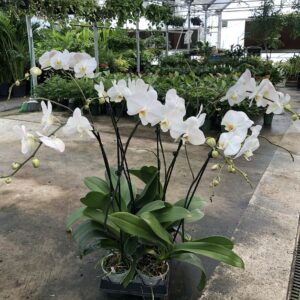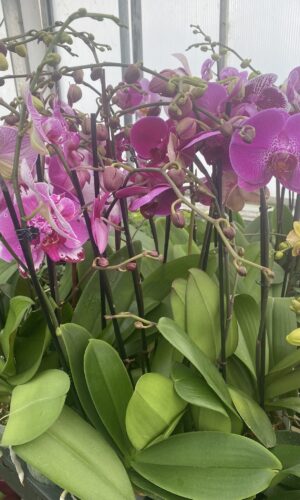
Orchid plants are one of the largest plant species in the world with over 20,000 different varieties. They are long-lived, and with proper care, bloom again and again for many years. The flowers of an orchid plant may be yellow, white, pink, lavender, spotted, or striped. The Phalaenopsis or Moth Orchid is one of the best and most available varieties. The flowers of a Phalaenopsis plant open off long arching spikes and often last 2-3 months.
There is an orchid plant for almost any lighting condition, but none like being in the direct sun. If an area is too dark, the leaves turn dark green instead of the grassy yellow green they should be and the orchid plant doesn’t bloom. If there is too much light, the leaves turn yellow and develop sunspots. A location near an east or west-facing window is usually the best location. Most orchid plants prefer about 10 hours of light a day.
The easiest way to kill any Orchid Plant is by over-watering. Always allow the top 50% of the potting compost to dry out before watering. Check the roots of an Orchid Plant monthly to be sure they are staying whitish green and plump. Set the plant in a deep saucer of water for about 30 minutes so it can absorb water through the drip holes in the bottom on the pot. Use tepid water that has not passed through a softener (too salty). If your household water has a lot of chemicals in it, allow the water to sit out over night before using it. Type of soil, temperature, time of year, humidity, and pot size all influence an orchid plant’s watering needs. Orchids dry out a little faster in the winter because of the heat in your home and low humidity.
Orchid plants do well when the temperature is 65°-80°F (18°-26° C) during the day and 15° cooler at night. In the fall, cool night temperatures help the flower spikes develop. Once the orchid buds appear try to keep the temperature constant or the buds may fall off.
High humidity, 50% or better, is essential. Setting an orchid plant in a stand and placing the stand in a tray filled with pebbles and water helps increase the humidity. Be sure the plant never sits directly in the water.
Orchid plants usually flower from December-May and the flowers can last several months. The spectacular blooms can be as small as 1″ or as large as 5″ depending upon the orchid variety. Try not to get water on the flowers.
Orchid plants are prone to Aphids, mealybug, scale, and spider mites. A good way to prevent insect infestations and diseases is to place an orchid where it gets good air circulation or is near a small fan. The slight breeze also encourages blooms to develop faster. The best ways to treat any insects or pests is to dab them off with a Qtip dipped in alcohol or wipe them off with a soft cloth dipped in soapy water
Orchid plants are prone to viruses, bacterial infections, and fungal infections. Increasing the air circulation around an is very beneficial in preventing diseases.
Orchid plants require a special soil and should never be planted in regular potting soil, it is much too dense. Use a bark-based or peat based soil that retains water, drains well, and allows the roots to “breathe.” Orchid plant soil should contain bark, sphagnum moss, and perlite. There are several commercial soils that are specifically for orchids.
Re-pot only if the potting medium has decomposed and is not draining quickly enough or if the orchid plant pseudobulbs have outgrown the pot. Remove the orchid from its old pot, shake off the soil around the pseudobulbs, place the plant in its new pot, and then fill in with the new potting mixture.
In nature, orchids get much of their food and water from the air, so never cut off any air roots that emerge from the soil. When the flower stalk turns yellow or brown, it’s time to prune. Cut the stalk back to about an inch from where it originated on the main stem. Use a clean razor blade or very sharp knife when pruning. Always remove any dead or diseased sections immediately, otherwise these sick areas of the plant attract more pests and diseases. Another pruning method for is to wait until your plant has finished blooming, look for tiny bumps or nodes on the flower spike. Find the third node from the bottom and cut the spike off 1″ above that node. Pruning an orchid plant helps the plant to produce more flowers during the next season.
Grow to new heights Open your account with us today and experience The Plant Factory difference






